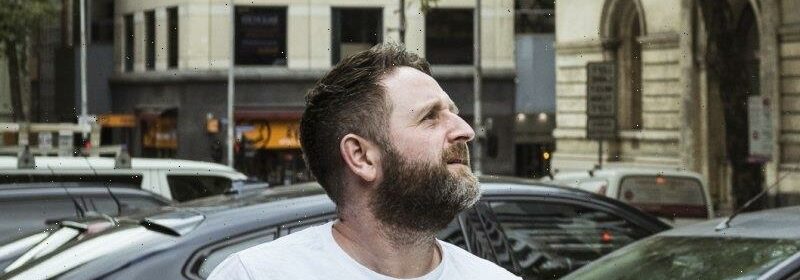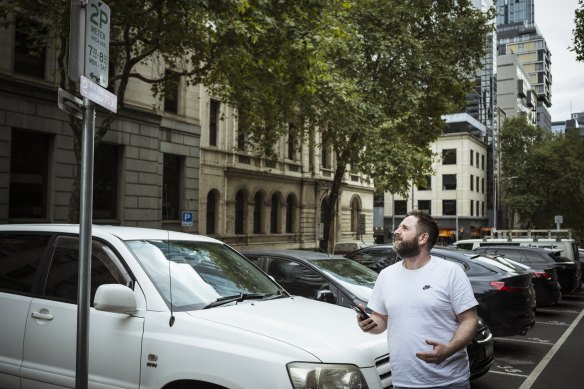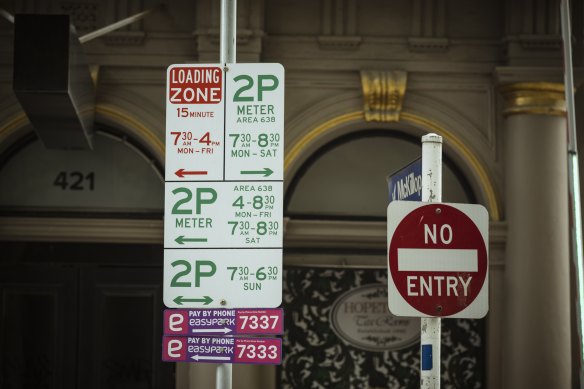Melbourne tackles ‘nightmare’ parking with new fees, clearer signs

The City of Melbourne could introduce “demand-led” pricing of street parking in different areas and times of the day as part of an effort to encourage motorists to use multi-storey car parks and unclog city streets.
Bamboozling street signs will also be simplified, new loading zones and disabled parking spaces introduced, and more kerbside space could be turned into footpaths, bike lanes or outdoor dining areas as part of the council proposed new parking strategy.
John Smith said he spent 15 minutes looking for a park in the CBD on Friday. Credit:Chris Hopkins
The council said the plan did not propose increasing its $7 an hour maximum parking metre price. But it does intend to adopt the new pricing model within the next two years.
That would see parking demand frequently reviewed and prices increased in areas where less the 5 per cent of street spots are available on average. Prices would fall in areas if more than a quarter of spaces are usually empty. Prices could also vary between different times of day, the plan says.
Cities around the world including New York, Madrid and Auckland use demand-based pricing, and report it reduces congestion and encourages availability and vehicle turnover, leading to more visitors to local businesses.
In San Francisco, which pioneered the model, prices vary between 50c and $9.25 ($14) an hour in normal times and prices are revised up or down by 25c every three months based on demand.
Eighty per cent of motorists who drove into the CBD said they found it “difficult or very difficult” to find on-street parking, the council found in a recent survey. Despite that, only 5 per cent went directly to “underutilised” off-street car parks, with the remainder adding to congestion while searching for a kerbside spot.
Parking became a hot-button issue last year when complaints from some businesses about the loss of kerbside space prompted the council to pause a rollout of new bicycle lanes.
But the draft plan, published on Friday afternoon, says the city does not recognise the value of the spaces parked cars take up and current meter prices fail to “encourage use of the significant off-street capacity”.
Parking meters are $7 an hour in the city centre and $4 an hour outside it, which compares to around $10 to $30 an hour in commercial CBD car parks during weekdays.
An example of the confusing parking signs the City of Melbourne says it will clean up. Credit:Chris Hopkins
John Smith experienced the frustration shared by many when he drove into the CBD on Friday for a work meeting and spent 15 minutes “going around in circles” before finally finding a park on Lonsdale Street just before noon.
“I’ve just been trying to find somewhere to stop. The actual parking garages, I’ve got no idea what they cost, so it’s a bit of a nightmare,” Smith said, adding he was held up further by needing to get out of his car and decipher the parking signage. “You have to spend five minutes reading it to try and work out what it means — it doesn’t make sense”.
The council’s draft parking plan says it will simplify signage and, where possible, the same rules will apply consistently across different times of the day and week. Parking fines should fall about 10 per cent by making signage less confusing, the council said.
Victorian Chamber of Commerce and Industry chief executive Paul Guerra, who lead the criticism which prompted the city to pause its bike lane program last year, said accessibility was a major deterrent from visiting the CBD which businesses wanted addressed.
“Car travel is the only option for some people and, if it’s made too hard or too expensive, they won’t come in at all,” Guerra said. “The city has already reduced available on-street carparks which has frustrated traders.”
The draft plan says one-third of people who visit the city for shopping or dining and entertainment drive there, and only half of those use on-street parking.
City of Melbourne has removed about one in five parking spots across the municipality since 2011 and replaced them with wider footpaths, trees, bike lanes and new tram stops. Parking spots were also turned into outdoor dining “parklets” during the pandemic.
There are now 1537 metered parking spaces in the CBD and 10,419 across the wider City of Melbourne area — which compares to 193,600 spaces in commercial car parks and residential buildings and office buildings.
Monash University urban planning lecturer Elizabeth Taylor said there were far more off-street car spaces in the CBD than people needed to use them, with her research previously finding up to 40 per cent of residential parking spots are empty. That space could be used better, so loading zones and disability parking could be prioritised on the street.
“The only way to meet all those other needs — like accessibility — is to move those visitors off the street,” she said.
Lord Mayor Sally Capp said the council wanted the parking system to be simpler and fairer, while helping people understand their options for finding the easiest park.
“Parking spaces are in high demand and used in many different ways,” she said in a statement. “We want to hear from the community… to make sure we get the balance right”.
The draft plan will go to councillors for endorsement at a meeting on March 21 and be open to community consultation until April 19. Councillors will vote on whether to put the plan into action.
The Morning Edition newsletter is our guide to the day’s most important and interesting stories, analysis and insights. Sign up here.
Most Viewed in National
From our partners
Source: Read Full Article

